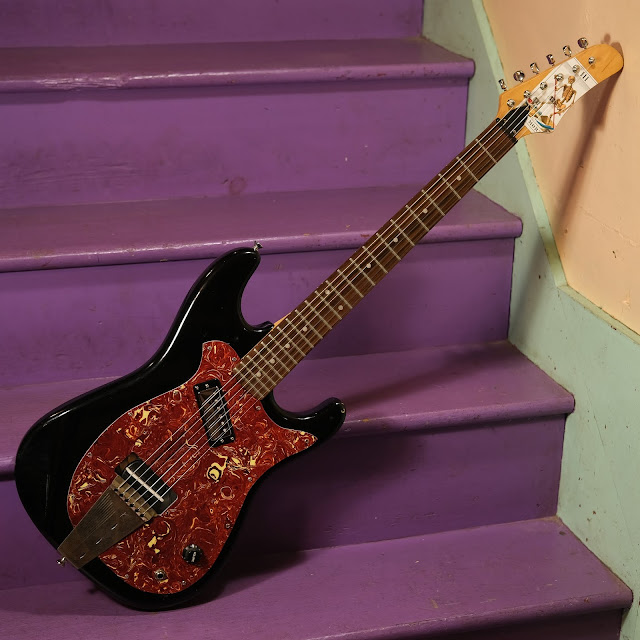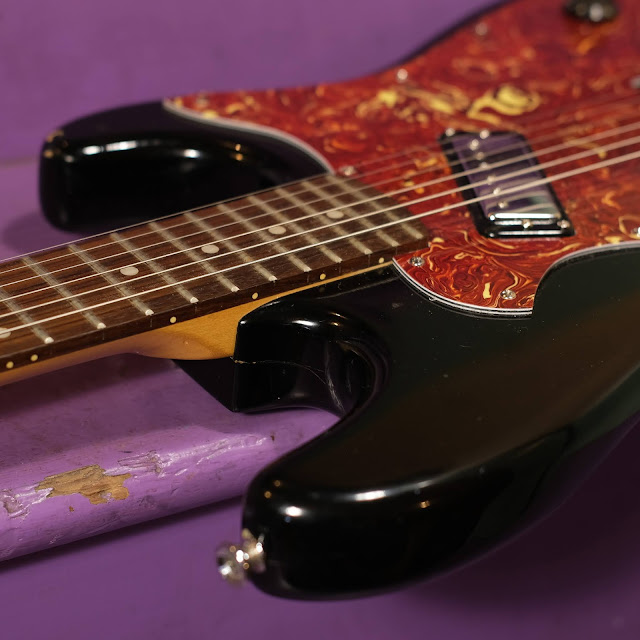1990s/2021 Partscaster Resonator Electric Guitar
One more partser special! This one is a jumble of a 1990s Hamer Slammer neck, same-era Peavey basswood body, and all sorts of decent hardware and randomness. The idea was to make an electric with just enough acoustic volume to hang-out on the couch with and strum and with a plugged-in sound that does something that other guitars don't do.
It has a 6" biscuit-bridge resonator cone (a resonator uke cone that handles the tension just fine, mind you) hiding under that pickguard and I even have an old 1930s National biscuit sitting on top of it. The body is hollowed-out via aggressive use of Forstner bits and the old whammy-cavity on the back lets sound vent out the rear and be deflected by an old Vermont license plate "coverplate" that's vented with some holes drilled in it. That part of the "speaker" actually sticks-out beyond your body if you hold the guitar "like a normal person" over the right leg... so it's audible in the room and not muffled.
My friend Rick showed-up 10 minutes or so after I finished this off and as he walked in the door he said something to the effect of, "what's that?" because... as you can hear in the videos... it just sounds different. It's clearly an electric guitar plugged into an electric guitar amp... but there are those resonator lingering overtones (without reverb added) and a banjo-like snap, shorter sustain, and directness to the notes. It sounds excellent in open tunings (as in the videos) and fingerpicked.
The pickup's a new Artec (Korean) Alnico II mini-humbucker with adjustable poles and I planted it along the lines of "retro Japanese" mounting angles. The pickguard's actually some good quality stuff and I cut it a bit freeform to follow the "swimming pool" cavity under the hood. It has an old '60s Kay tailpiece and the wiring harness has good components, a 500k pot, and uses shielded wire.
The rest of the stuff -- tuners and neckplate and string trees -- are Gotoh-made, good quality, and reliable. I've got a very tall bone saddle on the resonator biscuit and an old tarot card covers the Hamer references at the front of the headstock.
Is it fancy? Not at all. Does it do something different? Yes it does. Was it cheap to make? Sort-of! It's pretty time-intensive to get even silly projects like this one working right, but I've wondered for years about how this sort of setup would work with the reduced-size cone and a little extra airspace inside. I don't think it's any more successful or less successful than the cheaper version of the National Resolectric or similar, but it's definitely different in form factor and vibe.
Repairs included: cobbling, modding, wiring, slice-n-dicing, fret level/dress, you name it.
Made by: Hamer/Peavey/parts-bin
Body wood: basswood I believe
Bridge: 1930s National biscuit bridge w/new bone saddle
Fretboard: rosewood
Neck wood: maple
Pickups: 1x Artec Alnico II mini-humbucker
Action height at 12th fret: 1/16" overall (fast)
String gauges: 46w-10 regular lights, unwound G
Neck shape: slim-normal C
Board radius: ~14" or so
Truss rod: adjustable
Neck relief: straight
Fret style: medium
Scale length: 25 1/2"
Nut width: 1 11/16"
Condition notes: the body has some nicks and dings and signs of use but it's in overall decent shape. There are two finish hairline cracks at the neck pocket in the usual places -- right where the heel fits to the body. I had to snip the low E tuner plate a little to get it to fit better on the headstock and some of the tuner spacing is a little off due to non-standard shaft-hole distances but it all works-out just fine.
















Comments